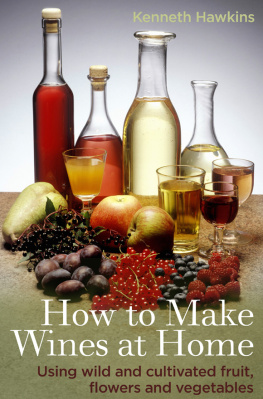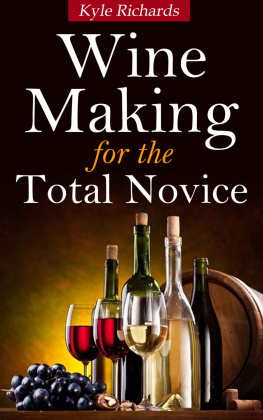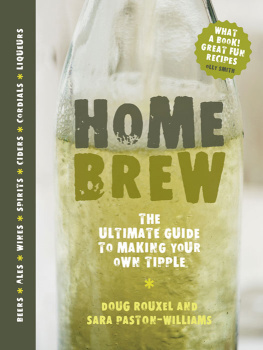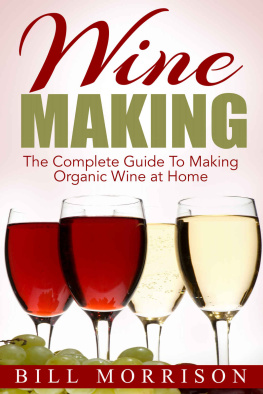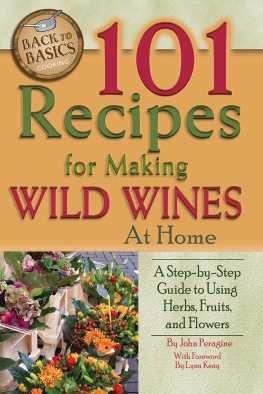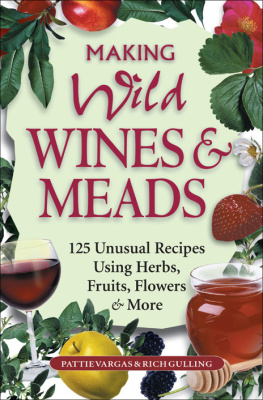HOW TO MAKE
WINES AT HOME
Also available from Constable & Robinson
Soups for Every Season
Traditional Country Preserving
Afternoon Tea
Everyday Thai Cooking
Everyday Lebanese Cooking
Everyday Curries
The Healthy Slow Cooker Cookbook
Everyday Bread from your Bread Machine
HOW TO MAKE
WINES AT HOME
Kenneth Hawkins

Constable & Robinson Ltd.
55-56 Russell Square
London WC1B 4HP
www.constablerobinson.com
First published in Great Britain in 1986 by Elliot Right Way
This paperback edition published in 2014 by Robinson
Copyright Elliot Right Way, 1986, 2014
The moral right of the author has been asserted.
All rights reserved.
No part of this publication may be reproduced, stored in a retrieval system, or transmitted, in any form, or by any means, without the prior permission in writing of the publisher, nor be otherwise circulated in any form of binding or cover other than that in which it is published and without a similar condition including this condition being imposed on the subsequent purchaser.
A CIP catalogue record for this book
is available from the British Library.
ISBN 978-0-71602-382-1 (paperback)
ISBN 978-0-71602-383-8 (ebook)
Typeset in Adobe Garamond by Basement Press, Glaisdale
Printed and bound in Great Britain by CPI Mackays
An Hachette UK Company
www.hachette.co.uk
CONTENTS
1
INTRODUCTION
Noah was the first man to plant the vine
He drank of the wine and was drunk Genesis
the story goes that he lived to the age of 350 years.
There was a time in my life when I did not make wine it was a long while ago, but I can still remember it vaguely. Before I was married, my father dabbled in the hobby, but neither his efforts, nor the results, interested me greatly, and although I have always been fond of good living, circumstances at that time only allowed for the tasting of a commercial wine on very rare occasions. My attitude to country wines was rather condescending it was a substitute, and I was a perfectionist. In any case, the hobby was not active enough for someone who was fond of almost any form of physical exercise. However, time goes by, as it is apt to do, and this, together with a rather serious illness, left me without a hobby, and feeling very sorry for myself.
To the clergyman who introduced me to winemaking, I shall be forever indebted, for he did much more than give me an absorbing hobby. He gave me a renewed interest in life at a time when it was really needed, and apart from that hobby, the introduction to a host of new friends through a winemaking club, and a comradeship there that I have rarely found elsewhere. (See for the advantages to be gained from belonging to a winemaking club).
As a result of my experience, my main concern has always been to try to help the beginner and in doing so to keep it simple. This is for two reasons: firstly as our hobby can be simple if that is what we want of it; and secondly, due to the fact that I am no chemist anyway. I may comment on many of the modern sophisticated items now available to us, but my strong advice to those about to take up this fascinating hobby is, do not initially buy a lot of expensive equipment learn your craft first, let your enthusiasm build up, and gradually add those little extras as you feel the need for them.
Though I hope to cover most aspects of the craft during the course of the book, the Purists may well be disappointed, for it will contain my personal experiences, some of which may not follow the accepted pattern. I do not apologise for this, since my results have brought a fair amount of success over the past few years, and in any case, I have found so many conflicting statements in some of the books that are now available, that I am sure that I am not alone in writing from my own experience.
Although this book is not intended to be a textbook for the experienced winemaker, I feel that many of the recipes, and their layout, may be of interest to all those who enjoy participation in the craft.
Winemaking has probably become one of the most popular craft hobbies and has many attractions for those who appreciate the odd glass of wine, either with a meal, or simply on a social occasion. In these days of high taxation, our own wines are relatively cheap to make, and the hobby gives a feeling of achievement in the same way as the ability to cook an excellent meal. But unlike cooking, it is a hobby that can occupy the individual for two hours a month or twenty, according to the time and space available, and the degree of enthusiasm that the hobby has created. (Before we go any further, it must be pointed out that the law in Great Britain allows us to make any amount of wine for our own consumption, but we must not sell a drop, or allow it to be sold for profit, as no duty has been paid. Neither are we allowed to distil).
The declared definition of wine is an alcoholic beverage made from the fermented juice of the grape, fermented in the country of origin all of which may be quite acceptable to the countries whose climates permit the growing of grapes in sufficient quantities to enable them to fulfil their needs, and possibly to export, but it is hardly satisfactory for countries such as the U.K. Nowadays the utilisation of other fruits etc. has become such an interesting craft that there are thousands of amateurs (and I use this word with trepidation, for many of them know a great deal both about the ingredients used, and the commercial wines of the world) who are quite capable of making an alcoholic drink which is at least the equal of the middle range commercial product. Of course there are many whose efforts leave much to be desired producing alcoholic drinks, perhaps, but for one reason or another, not up to the standard.
I hope that this book will enable anyone, even those who are new to the craft, to reach an acceptable level. By this I do not mean that all wines should become copies of the commercial product, but simply that we use them as a comparison for quality, as obviously a commercial wine must have a market value, and this becomes the best standard the amateur winemaker has to set against his or her own efforts.
As you will see, our home-made wines can be produced from an infinite variety of ingredients flowers, fruit, grain, honey, leaves and vegetables but experience will probably show that the best results will usually be obtained from a recipe that includes an element of fruit in it, otherwise there may be a tendency for a lack of vinosity in the finished wine. By all means experiment with other available ingredients later on, but it is better for the beginner to learn his or her craft first, before going into the intricacies of blending ingredients without the aid of a proven recipe.
Home-made wines have been made in this country for hundreds of years, using fruits from the hedgerows, flowers, vegetables etc., with honey as the sweetening agent. The first set-back to home winemaking came when the Bordeaux area fell under British rule, and for many years imports of French wines were enjoyed by the more prosperous, leaving the making of country wines to the poorer classes. Later, when those territories were lost, wines were imported from Portugal, with whom Britain had a trade treaty. In the eighteenth century the quantity of sugar imported caused the price to fall within reach of the working man, and from then onwards the use of honey declined, and gradually malt beers began to take over. As a nation, the making of wines declined, and it was indeed fortunate for us that our forebears kept, and handed down, many of the old recipes, for they are still the basis of some of our country wines today.
Next page
